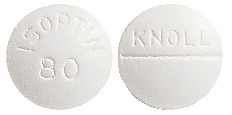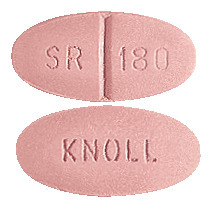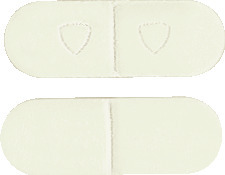SUMMARY CMI
ISOPTIN® and ISOPTIN® SR
Consumer Medicine Information (CMI) summary
The full CMI on the next page has more details. If you are worried about using this medicine, speak to your doctor or pharmacist.
1. Why am I using ISOPTIN?
In most parts of this leaflet, the name ISOPTIN is used to refer to both ISOPTIN tablets and ISOPTIN SR tablets. Where there is information specific to the type of ISOPTIN, separate names are used.
ISOPTIN contains the active ingredient verapamil hydrochloride. ISOPTIN and ISOPTIN SR are used for high blood pressure (hypertension) and angina (chest pain). ISOPTIN is also used to treat irregular heartbeats, also called arrhythmias.
For more information, see Section 1. Why am I using ISOPTIN? in the full CMI.
2. What should I know before I use ISOPTIN?
Do not use if you have ever had an allergic reaction to ISOPTIN or any of the ingredients listed at the end of the CMI.
Talk to your doctor if you have any other medical conditions, take any other medicines, or are pregnant or plan to become pregnant or are breastfeeding.
For more information, see Section 2. What should I know before I use ISOPTIN? in the full CMI.
3. What if I am taking other medicines?
Some medicines may interfere with ISOPTIN and affect how it works. A list of these medicines is in Section 3. What if I am taking other medicines? in the full CMI.
4. How do I use ISOPTIN?
ISOPTIN is usually taken two or three times a day. The usual dose of ISOPTIN SR is once daily or they may be taken twice daily.
More instructions can be found in Section 4. How do I use ISOPTIN? in the full CMI.
5. What should I know while using ISOPTIN?
| Things you should do |
|
| Things you should not do |
|
| Driving or using machines |
|
| Drinking alcohol |
|
| Looking after your medicine |
|
For more information, see Section 5. What should I know while using ISOPTIN? in the full CMI.
6. Are there any side effects?
Tell your doctor if you notice any of the following and they worry you: constipation, dizziness, light-headedness, feeling sick, upset stomach, headache, tiredness and flushing. These are more common side effects of your medicine.
Tell your doctor immediately if you notice any of the following: chest pain, fainting, irregular heart beat, shortness of breath which may occur with swelling of feet and legs due to fluid built up, fever, upper stomach pain, feeling generally unwell, severe blisters, skin rash, itching or flaking skin.
For more information, including what to do if you have any side effects, see Section 6. Are there any side effects? in the full CMI.
FULL CMI
ISOPTIN® and ISOPTIN® SR
Active ingredient: verapamil hydrochloride
Consumer Medicine Information (CMI)
This leaflet provides important information about using ISOPTIN. You should also speak to your doctor or pharmacist if you would like further information or if you have any concerns or questions about using ISOPTIN.
There are two types of ISOPTIN:
- ISOPTIN tablets (available as 40 mg and 80 mg tablets)
- ISOPTIN SR (available as 180 mg and 240 mg tablets)
The letters SR in the name ISOPTIN SR stand for "sustained release". This means the medicine is released into the blood over an extended period of time, usually allowing the medicine to be taken once a day.
In most parts of this leaflet, the name ISOPTIN is used to refer to both ISOPTIN tablets and ISOPTIN SR tablets. Where there is information specific to the type of ISOPTIN, separate names are used.
Where to find information in this leaflet:
1. Why am I using ISOPTIN?
2. What should I know before I use ISOPTIN?
3. What if I am taking other medicines?
4. How do I use ISOPTIN?
5. What should I know while using ISOPTIN?
6. Are there any side effects?
7. Product details
1. Why am I using ISOPTIN?
ISOPTIN contains the active ingredient verapamil hydrochloride. ISOPTIN and ISOPTIN SR belong to a group of medicines called calcium channel blockers or calcium antagonists. They work by opening up blood vessels, which lets more blood and oxygen reach the heart and at the same time lowers high blood pressure. ISOPTIN tablets also help to control fast or irregular heartbeats.
ISOPTIN does not change the amount of calcium in your blood or bones. Calcium in your diet or in calcium supplements will not interfere with the way ISOPTIN works.
ISOPTIN and ISOPTIN SR are used to treat high blood pressure (hypertension) and angina (chest pain). ISOPTIN is also used to treat irregular heartbeats, also called arrhythmias.
ISOPTIN SR is not recommended for use in children under the age of 18, as there have been no studies of its effects in this age group.
There is no evidence that ISOPTIN is addictive.
2. What should I know before I use ISOPTIN?
Warnings
Do not use ISOPTIN if:
- you are allergic to verapamil hydrochloride, or any of the ingredients listed at the end of this leaflet. Some of the symptoms of an allergic reaction may include: shortness of breath, wheezing or difficulty breathing, swelling of the face, lips, tongue or other parts of the body, rash, itching or hives on the skin.
Always check the ingredients to make sure you can use this medicine. - You have certain heart conditions (such as heart failure, a very slow heart rate, heart conduction problems, some irregular heartbeats or disease of the heart muscle).
- You have low blood pressure, also called hypotension.
- You are taking medicines containing ivabradine, Direct Oral Anticoagulants (DOACs) such as dabigatran (in certain situations).
- The packaging is torn or shows signs of tampering.
Check with your doctor if you have or have had any of the following medical conditions:
- any other heart problems
- blood vessel (circulatory) disease or a stroke
- liver or kidney problems
- neuromuscular conditions such as Duchenne muscular dystrophy, myasthenia gravis, Lambert-Eaton syndrome.
During treatment, you may be at risk of developing certain side effects. It is important you understand these risks and how to monitor for them. See additional information under Section 6. Are there any side effects?
Pregnancy and breastfeeding
Tell your doctor if you are pregnant or plan to become pregnant.
ISOPTIN may affect your baby if you take it in pregnancy. Your doctor will discuss the possible risks and benefits of taking ISOPTIN during pregnancy.
Tell your doctor if you are breastfeeding or plan to breastfeed.
ISOPTIN passes into breast milk. Your doctor will discuss the possible risks and benefits of taking ISOPTIN when breastfeeding.
3. What if I am taking other medicines?
Tell your doctor or pharmacist if you are taking any other medicines, including any medicines, vitamins or supplements that you buy without a prescription from your pharmacy, supermarket or health food shop.
Some medicines may interfere with ISOPTIN and affect how it works.
Medicines to treat heart problems or high blood pressure:
- Beta-blockers e.g. atenolol, propranolol, metoprolol
- Ivabradine
- Digoxin
- Medicines used to control irregular heartbeat e.g. quinidine, flecainide, amiodarone, disopyramide
- Medicines used to control high blood pressure, especially prazosin or terazosin
Medicines used to lower cholesterol:
- Statins such as atorvastatin or simvastatin
Medicines used to treat or prevent blood clots (sometimes referred to as "blood thinners"):
- Direct Oral Anticoagulants (DOACs) such as dabigatran
- Aspirin
Medicines used to treat or prevent gout:
- Colchicine, sulfinpyrazone
Medicines used to treat psychological problems
- Medicines to treat depression, or psychosis such as St John's Wort, imipramine, buspirone, midazolam or lithium
Medicines to treat epilepsy or seizures:
- Phenytoin, carbamazepine, phenobarbital
Medicines to treat or prevent organ transplant rejection:
- Cyclosporin, everolimus, sirolimus, tacrolimus
Medicines used to treat infections or tuberculosis:
- Such as erythromycin, clarithromycin, telithromycin or rifampicin
Medicines used in the treatment of Human Immunodeficiency Virus (HIV):
- Such as ritonavir
Medicines used in surgical procedures:
- General anaesthetics used for inducing sleep
- Muscle relaxants
Other medicines that may react with ISOPTIN:
- Theophylline, a medicine used to treat asthma
- Doxorubicin, a medicine used to treat certain cancers
- Cimetidine, a medicine commonly used to treat stomach ulcers and reflux
- Metformin and glibenclamide, medicines used to treat diabetes
- Aspirin
- Almotriptan
Avoid alcohol while using ISOPTIN. You may experience greater blood pressure lowering effects than usual.
Avoid grapefruit juice, as this may increase the blood levels of verapamil.
Check with your doctor or pharmacist if you are not sure about what medicines, vitamins or supplements you are taking and if these affect ISOPTIN.
4. How do I use ISOPTIN?
How much to take
- Your doctor will tell you how many tablets you will need to take each day and when to take them. This depends on your condition and whether you are taking any other medicines.
- ISOPTIN tablets are usually taken two or three times a day.
- The usual dose of ISOPTIN SR is once daily or they may be taken twice daily.
- Treatment with ISOPTIN is usually long term. Keep taking ISOPTIN for as long as your doctor recommends.
When to take ISOPTIN
- Take ISOPTIN SR with food.
- ISOPTIN 40 mg and 80 mg tablets can be taken with or without food.
How to take ISOPTIN
- Swallow ISOPTIN with a glass of water.
- ISOPTIN 40 mg and 80 mg tablets are to be swallowed whole. They are not meant to be broken.
- ISOPTIN SR tablets can be broken in half if your doctor has prescribed half a tablet.
- Do not crush or chew ISOPTIN SR tablets.
If you forget to use ISOPTIN
If it is almost time for your next dose, skip the dose you missed and take your next dose when you are meant to. Otherwise, take it as soon as you remember, and then go back to taking your medicine as you would normally.
Do not take a double dose to make up for the dose you missed.
This may increase the chance of you getting an unwanted side effect.
If you miss more than one dose, or are not sure what to do, check with your doctor or pharmacist.
If you use too much ISOPTIN
If you think that you have used too much ISOPTIN, you may need urgent medical attention.
You should immediately:
- phone the Poisons Information Centre
(Australia telephone 13 11 26); New Zealand telephone 0800 POISON or 0800 764 766 for advice, or - contact your doctor, or
- go to the Emergency Department at your nearest hospital.
You should do this even if there are no signs of discomfort or poisoning.
If you take too much ISOPTIN, you may have difficulty breathing, a slow heartbeat, chest pain, feel very faint or collapse; however, if you are taking ISOPTIN SR (sustained release) tablets the medicine is released into the blood over an extended period of time, so you may not notice these symptoms immediately.
5. What should I know while using ISOPTIN?
Things you should do
- If you become pregnant while taking ISOPTIN, tell your doctor.
- Tell all doctors, dentists and pharmacists who are treating you that you are taking ISOPTIN.
- If you are going to have surgery including dental surgery, tell your doctor or dentist that you are taking ISOPTIN.
- Visit your doctor regularly so that they can check on your progress.
- Your doctor may ask you to have blood tests to check your liver from time to time.
Call your doctor straight away if you:
- are being treated for angina, tell your doctor if you continue to have angina attacks or if they become more frequent while you are using ISOPTIN.
Remind any doctor, dentist or pharmacist you visit that you are using ISOPTIN.
Things you should not do
- Do not stop taking ISOPTIN, or lower the dosage without checking with your doctor.
- Do not take ISOPTIN with grapefruit or its juice.
- Do not give ISOPTIN to anyone else, even if they have the same condition as you.
- Do not take ISOPTIN to treat any other complaints unless your doctor tells you to.
Be careful getting up from a sitting position
- Dizziness, light-headedness or fainting may occur, especially when you get up quickly. Getting up slowly may help.
Driving or using machines
Be careful before you drive or use any machines or tools until you know how ISOPTIN affects you.
ISOPTIN may cause dizziness, light-headedness or tiredness in some people. If this occurs, do not drive, operate machinery or do anything else that could be dangerous.
Drinking alcohol
Tell your doctor if you drink alcohol.
If you drink alcohol while taking ISOPTIN, dizziness or light-headedness may be worse.
Looking after your medicine
- Keep ISOPTIN tablets below 25°C.
- Keep your tablets in the pack until it is time to take them.
Follow the instructions in the carton on how to take care of your medicine properly.
Store it in a cool dry place away from moisture, heat or sunlight; for example, do not store it:
- in the bathroom or near a sink, or
- in the car or on window sills.
Keep it where young children cannot reach it.
Getting rid of any unwanted medicine
If you no longer need to use this medicine or it is out of date, take it to any pharmacy for safe disposal.
Do not use this medicine after the expiry date.
6. Are there any side effects?
All medicines can have side effects. If you do experience any side effects, most of them are minor and temporary. However, some side effects may need medical attention.
As with most medicines, if you are over 65 years of age you may have an increased chance of getting side effects. Report any side effects to your doctor promptly.
See the information below and, if you need to, ask your doctor or pharmacist if you have any further questions about side effects.
Less serious side effects
| Less serious side effects | What to do |
| Speak to your doctor if you have any of these more common side effects and they worry you. |
Serious side effects
| Serious side effects | What to do |
| Call your doctor straight away, or go straight to the Emergency Department at your nearest hospital if you notice any of these serious side effects. |
Tell your doctor or pharmacist if you notice anything else that may be making you feel unwell.
Other side effects not listed here may occur in some people.
Reporting side effects
After you have received medical advice for any side effects you experience, you can report side effects to the Therapeutic Goods Administration online atwww.tga.gov.au/reporting-problems or New Zealand at nzphvc.otago.ac.nz/reporting. By reporting side effects, you can help provide more information on the safety of this medicine.
Always make sure you speak to your doctor or pharmacist before you decide to stop taking any of your medicines.
7. Product details
This medicine is only available with a doctor's prescription.
What ISOPTIN 40mg and 80mg contain
| Active ingredient (main ingredient) | verapamil hydrochloride |
| Other ingredients (inactive ingredients) | calcium hydrogen phosphate dihydrate microcrystalline cellulose croscarmellose sodium magnesium stearate colloidal anhydrous silica hypromellose purified talc sodium lauryl sulfate macrogol 6000 titanium dioxide |
What ISOPTIN 180 SR contains
| Active ingredient (main ingredient) | verapamil hydrochloride |
| Other ingredients (inactive ingredients) | sodium alginate microcrystalline cellulose povidone magnesium stearate hypromellose macrogol 400 macrogol 6000 purified talc titanium dioxide iron oxide red glycol/butylene glycol montanate |
What ISOPTIN 240 SR contains
| Active ingredient (main ingredient) | verapamil hydrochloride |
| Other ingredients (inactive ingredients) | sodium alginate powdered cellulose povidone magnesium stearate hypromellose purified talc macrogol 400 macrogol 6000 titanium dioxide quinoline yellow indigo carmine glycol/butylene glycol montanate purified water |
Do not take this medicine if you are allergic to any of these ingredients.
What ISOPTIN looks like
ISOPTIN 80mg is white, biconvex film coated tablet, embossed "Isoptin 80" on the front and "Knoll" above the score on the back (AUST R 65503).
ISOPTIN SR 180mg is old rose, oval film coated tablet. ‘KNOLL’ on one face and ‘SR’; score; ‘180’ on the other face (AUST R 54032).
ISOPTIN SR 240mg is light green, oblong film-coated tablet (curved tooling). Score and 2 logos on one face and score on the other face. (AUST R 12801)
Who distributes ISOPTIN
Viatris Pty Ltd
Level 1, 30 The Bond
30-34 Hickson Road
Millers Point NSW 2000
www.viatris.com.au
Phone: 1800 274 276
This leaflet was prepared in Jun 2025.
ISOPTIN® is a Viatris company trade mark
ISOPTIN_cmi\Jun25/00
Published by MIMS August 2025





